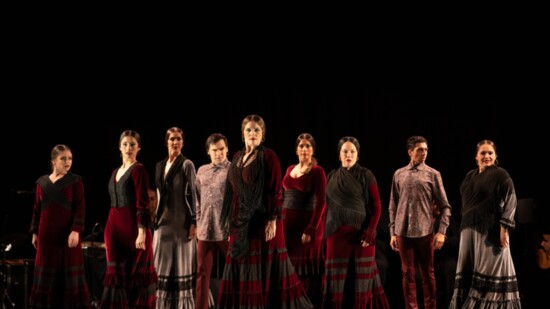Flamenco, comprising of baile (dance), cante (singing), and toque (guitar playing), is rooted in Andalucía, the southernmost autonomous region of Peninsular Spain. This expressive art form often involves improvisation and theatricality in its dance. Its origins can be traced back to the 15th century when gypsies migrated from India, Egypt, and Iran, blending their Roma, Sephardic Jewish, and Moorish influences with local cultures. This fusion of traditions brought forth Flamenco's rich music, dance, and cultural tapestry, which continues to captivate audiences today, primarily in Spain. However, its presence may not be expected in places like Albuquerque.
Albuquerque holds the title of the Flamenco Capital of North America and is home to the prestigious National Institute of Flamenco. Annually, the institute holds “Festival Flamenco Albuquerque,” recognized as the largest flamenco festival outside of Spain. Eva Encinias, the founding director of the National Institute of Flamenco, emphasizes the organization’s commitment to preserving this ancient art form. She says, “We’re so fortunate to have a lot of really good Flamenco in this state, and I am proud of that – that wasn’t the case when I was a young girl.” Since Encinias initiated the concentrated dance program at the University of New Mexico through the National Institute of Flamenco, numerous students have studied the art of Flamenco. Encinias, who has performed, taught dance, and served on the faculty for 43 years, has been instrumental in inspiring aspiring Flamenco dancers to master Flamenco. She says, “We have an extensive Flamenco dance program.” Her daughter, Marisol, followed in her footsteps, teaching and running the Flamenco Institute.
The National Institute of Flamenco delivers captivating weekly performances at Tablao Flamenco inside the Hotel Albuquerque. Artists from Spain and the United States enthrall audiences with narratives of heartbreak, passion, and joy, showcasing mesmerizing hand clapping, intricate arm movements, and rhythmic footwork. The venue hosts dinner shows on Friday and Saturday nights, along with popular Sunday matinees, all designed to immerse guests in an intimate and authentic "tablao" experience, meticulously crafted with attention to every detail, including lighting. Among the performers is Albuquerque's own Yjastros: The American Flamenco Repertory Company, renowned for their group performances and innovative choreography that brings a fresh perspective to Flamenco.
Encinias is also a performer at Tablao Flamenco. She says everything in Flamenco is heavily laced with rhythm. “The basis of that is the palmas (hand clapping). You look at the guitar and it’s the blending of a melodic instrument but also a percussive instrument. The dancing, of course, also has a lot of lyricism, but always has an underlying presence of rhythm.”
New Mexican Flamenco is unique because it melds together the diverse cultures and influences of the people who live here. Encinias says, “The Native American, Anglo, Spanish, and Mexican influences…all of those things have an inspiration to and influence on the art form.” She says Albuquerque’s Flamenco community is well-known and respected, even within Spain.
Flamenco has been preserved across generations and sustained through family gatherings, beyond formal performances in theaters and tablaos. Encinias says, “It’s in that format that you get much of the greatest improvisation because they’re completely free to just explore and respond to each other as musicians and dancers.”
Today, “tablao” venues can be found across Spain and in a coveted hotspot in Albuquerque. Encinias says, “All of this rhythm comes together to create such a dynamic between the performers, and that’s exciting!” Visit https://www.tablaoflamenco.org to learn more.
We’re so fortunate to have a lot of really good Flamenco in this state and I’m proud of that. It wasn't the case when I was a young girl.
Flamenco’s roots can be traced to the gypsies who migrated from India, Egypt, and Iran in the 15th century. The melding of Roma, Sephardic Jewish, and Moorish cultures also influenced Flamenco dance. Each group brought their music, dance, and culture to share with Spain.




